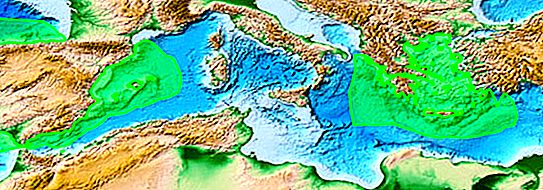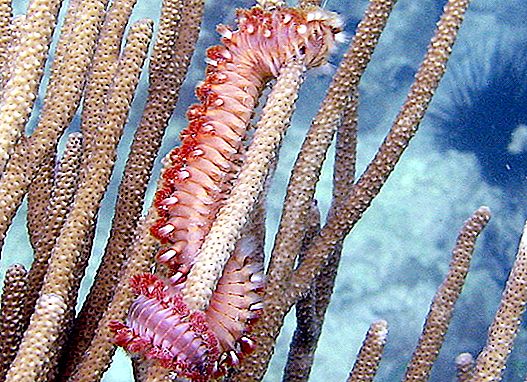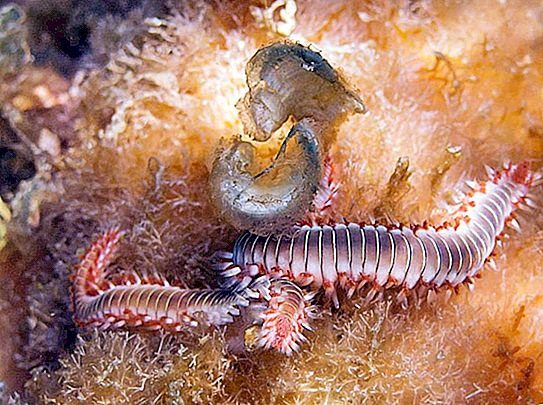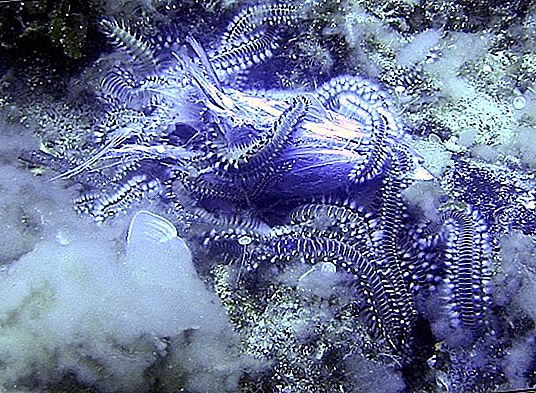The fireworm got its name not for its bright color, but for the “burning” consequences of contact with human skin. Its main protection is fluffy needle-hairs, which can cling and cause burns and other signs of intoxication.
Biological Description and Structure
The fireworm (Bearded fireworm, lat. Hermodice carunculata), according to the classification, belongs to the polychaete family Amphinomidae, a class of ringed marine worms, which number more than 10 thousand species in the world. It is also called a bearded or bristle worm.
Outwardly, it strongly resembles a centipede with an elongated and flattened trunk, consisting of several segments, snow-white silky setae and gills located on the sides. As you can see in the photo of the fireworm, his whole body consists of a large number of bright orange segments, each of which has a bunch of fluffy and beautiful white bristles. Its color can vary from yellow-green to red-gray or white with a pearl shade.
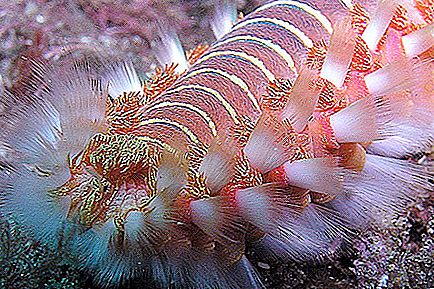
The number of segments is from 60 to 150, they are separated from each other by a thin white line and protected by a cuticle in the form of a bundle of long villi. Each segment has a pair of muscular outgrowths on the body (parapodia), which are designed for movement, digging and swimming, as well as poisonous bristles and red-orange gills.
The front part of the worm can be recognized by small sprouts - caruncles, which are colored like gills in the first 4 segments. The mouth is located on the 2nd segment, the head includes the eyes and other senses. The size of adults is usually 5-10 cm, but can reach 30-40 cm.
Habitat
Sea worms live at a depth of 1 to 100 m. They prefer to live in coral reefs between stones, in mud, sand and wood, in silty places.
Fireworm distribution area: Mediterranean Sea, coast of Turkey, Italy, Cyprus, Malta, in the tropical and subtropical coastal waters of the Atlantic Ocean, on Ascension Island. They are also found in the southeastern United States, in the Gulf of Mexico and the Caribbean. On the map below, these places are marked in green.
Food
Sea fireworm is a voracious predator. Its diet consists of hard corals, anemones and small crustaceans, sometimes plants also come here. If possible, it attacks the larger underwater inhabitants: wounded starfish, rock urchins. And although the worms do not have any claws or powerful jaws, the hunt for them always ends successfully, especially in a situation where these creatures are attacked by a group of several individuals. As shown by the experiments of biologists who planted hedgehogs and worms in one aquarium, the latter are able to gnaw the victim from the inside, crawling into her mouth.
When fed in reefs, they eat corals, their upper parts and branches. At the same time, they remove the coral layer directly from the skeleton, leaving behind white tips. This is a characteristic sign of their presence in this place. The process of peeling each branch of coral takes 5-10 minutes. Therefore, in one day they cause quite noticeable damage to all corals around.
Worm Reproduction
Arthropods of the polychaeta class (Latin: Polychaeta) are gonochoric (sexual) worms. Before mating, the female produces pheromone, which attracts males and signals its readiness. Female secretions have a greenish phosphorescent glow, which dissolves in water. It is to the light that males sail. At the same time, they secrete their luminous fires and semen, which is laid on laid eggs. Such a process is called swarming (“swarming”), with it sex cells unite and fertilize.
Reproduction occurs through metanephridia or tears in the body wall. After fertilization, the eggs are converted to plankton, some of them are stored in the pipes of the worm or in a jelly-like mass, which is attached to the pipes (called egg broilers).
At the next stage, trocophore larvae emerge from the eggs, which then degenerate into the juvenile stage with a longer body. Then they gradually grow to adulthood.
Usually this happens in the summer months, and only in the first quarter of the moon phase, and lasts 1-2 days. These 2 nights after sunset, the sea turns green, which lasts about 30 minutes.
Examination of an unusual glow
Biologists were able at that moment to catch bristle fireworms for research in the laboratory. They showed that the glow can be observed under certain conditions: to a temperature of -20 ° C, but gradually fades away as it decreases. Reducing the level of oxygen does not affect the glow.
Analyzing the obtained data, biologists made conclusions about the presence of photoprotein in the secretion of such marine worms. For the discovery of this substance in 2008, the Japanese biologist O. Shimomura received the Nobel Prize in chemistry.
Danger to people
They pose the greatest danger to inexperienced divers who make underwater trips. Fireworms lead a bottom lifestyle, occur in shallow water and in deeper waters, and move very slowly. Therefore, they do not threaten anyone, unless they are touched. However, with an accidental or special touch, the worm shoots with its long needle-bristles.
Each hair bristle is hollow inside and contains a poisonous neurotoxin, which causes severe burning pain and, as a result, general poisoning of the body. This will not lead to tragic consequences, but discomfort is provided.
The toxic effect is manifested in the following negative symptoms:
- burning and burning sensations at the place of contact with the hair;
- redness and inflammation on the skin;
- gradual increase in edema and numbness;
- nausea and dizziness;
- fever.
The negative signs of poisoning persist for several hours, then usually only a painful tingling sensation remains in the area of contact with the poison.
Fireworms can stumble upon a wild beach on the Mediterranean coast, where they are found among stones in shallow water. Therefore, in such a situation, it is recommended to wear special rubber slippers.
First aid
The very first step is to remove the visible bristles with tweezers. Those that are almost invisible or transparent, can be removed using tape or any adhesive tape. Then treat the affected area with a disinfectant or vinegar solution, ethyl alcohol. If the pain and irritation do not go away for a long time, it is better to consult a specialist and be treated with an antibiotic ointment. Hydrocortisone-based cream helps a lot. To relieve pain, pain medication is recommended: Ibuprofen, Nurofen, etc.
With the onset of inflammation or infection of the wound, it is better to use external antibiotics.

